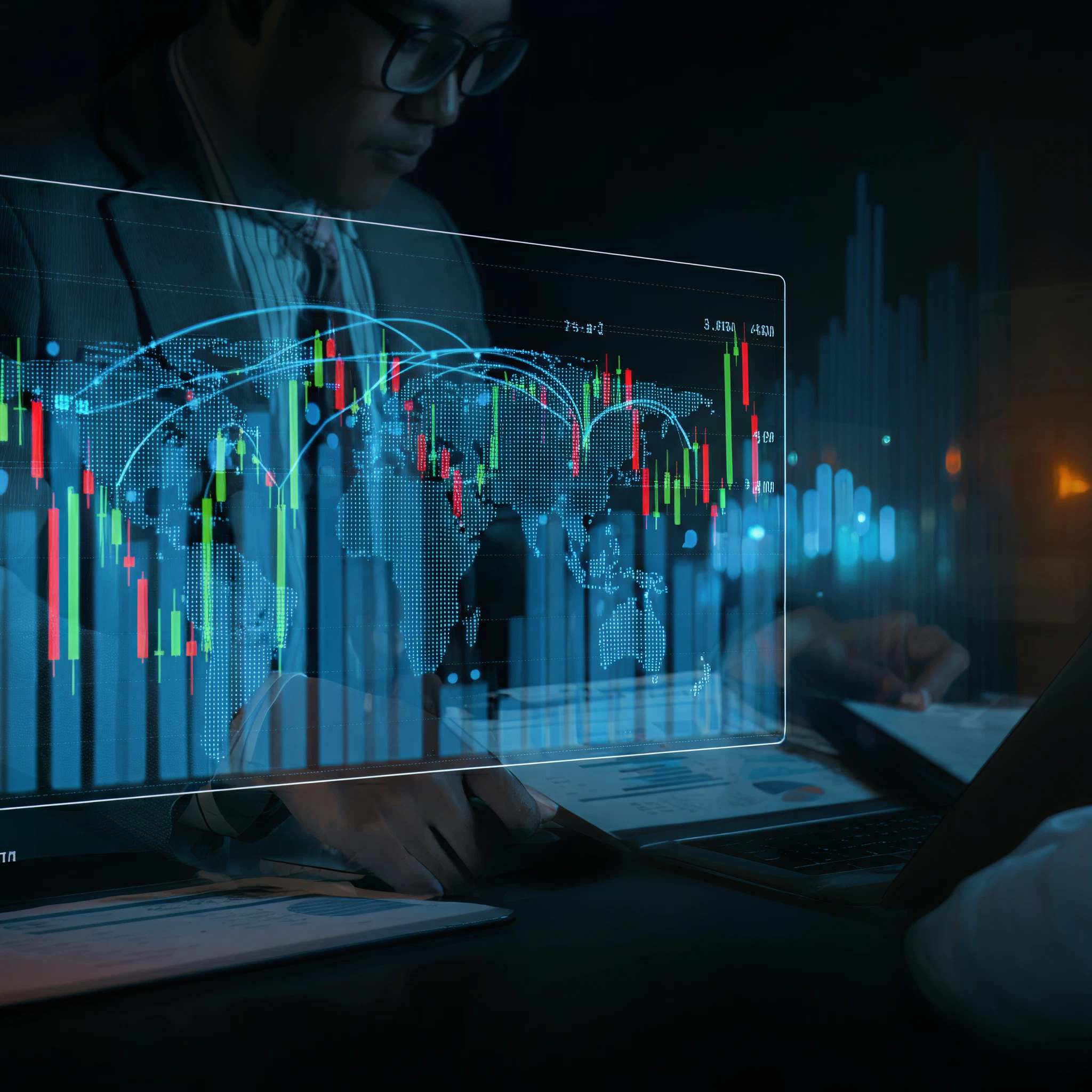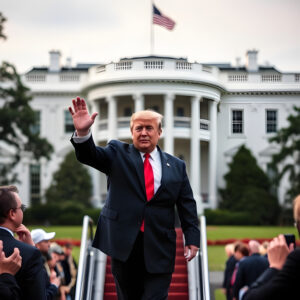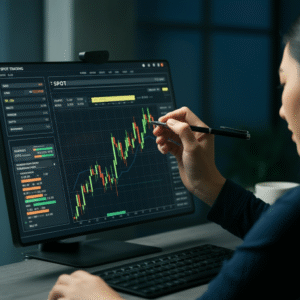Since the Trump administration’s tenure, the seismic shifts felt across the global economic landscape have far from settled. The vivid aftershocks of former President Donald Trump’s economic policies continue to ripple, from cryptocurrency markets to traditional equities, global trade, and investor sentiment.
For investors, financial analysts, and policymakers, understanding how these policies sow uncertainty is vital to navigating today’s unpredictable financial ecosystem.
This comprehensive guide will break down the legacy of Trump-era economics and how the associated strategies are fueling ongoing market volatility, offering insights for those looking to ride the waves of uncertainty and understand emerging opportunities.
The Legacy of Trump-Era Economics
In 2016, Donald Trump took office as the President of the United States with a promise to revitalize the American economy. His administration’s economic policies focused on reducing taxes, deregulating industries, and promoting trade protectionism.
At first, these policies seemed to have a positive impact on the stock market and overall economic growth. However, as time passed, it became clear that the long-term effects of these policies were not so straightforward.
Tax Cuts and Deregulation
One of the key pillars of Trump-era economics was tax cuts for both individuals and corporations. These tax cuts were intended to stimulate consumer spending and incentivize businesses to invest and expand. Additionally, the Trump administration pursued a policy of deregulation, with the aim of reducing the burden on businesses and promoting growth.
While these policies did result in short-term boosts to the stock market and GDP growth, they also had some unintended consequences. For one, the tax cuts primarily benefited wealthy individuals and corporations, leading to further income inequality. Additionally, the push for deregulation raised concerns about potential negative impacts on consumer safety and environmental protection.
Impact on International Trade
Another significant aspect of Trump’s economic policies was his approach towards international trade. The administration imposed tariffs on various goods from countries like China and Mexico in an effort to reduce the trade deficit and bring back manufacturing jobs to the United States. However, these tariffs were met with retaliation from other countries and sparked fears of a trade war. This approach towards international trade also strained relationships with allies such as Canada and the European Union, who were also hit with tariffs. This led to increased tensions and uncertainty in the global economy. Furthermore, Trump’s withdrawal from international agreements like the Trans-Pacific Partnership (TPP) and renegotiation of the North American Free Trade Agreement (NAFTA) created uncertainty for businesses and investors. The unpredictable nature of these actions made it difficult for companies to make long-term plans and investments, potentially hindering economic growth.
Impact on Immigration
Immigration was another area where Trump’s policies had a significant impact on the global economy. His hardline stance on immigration, including implementing a travel ban from several Muslim-majority countries and increasing deportations of undocumented immigrants, sparked international backlash and affected the movement of people across borders.This had implications for businesses that rely on foreign workers or have operations in different countries. Restrictions on immigration can make it difficult for companies to access skilled labor and fill critical positions, ultimately hindering their ability to compete globally.In addition, restrictions on immigration can also negatively impact sectors such as tourism and hospitality, where a significant portion of customers are international travelers. The decreased flow of tourists can result in lost revenue for these industries and have ripple effects throughout the economy.
The Legacy of Trump-Era Economics: Navigating Uncertainty in the Financial Markets
The presidency of Donald J. Trump has been marked by unprecedented economic policies and actions that have had far-reaching effects on global financial markets. From trade tariffs and tax cuts to deregulation and a confrontational stance towards China, these policies have stirred up both support and criticism.As we look back at his term in office, it’s evident that the legacy of Trump-era economics will continue to shape the financial landscape for years to come. But what exactly are these policies and how have they impacted the world of finance? And more importantly, how can investors navigate this era of uncertainty? In this section, we will delve deeper into the key economic policies of the Trump administration and their effects on financial markets.
The Tax Cuts and Jobs Act
One of President Trump’s most significant actions in office was signing the Tax Cuts and Jobs Act (TCJA) into law in 2017. This sweeping legislation aimed to stimulate economic growth by reducing corporate tax rates from 35% to 21%, as well as providing tax cuts for individuals and small businesses. On one hand, supporters of the TCJA argue that it has led to increased investment and job creation, as well as a boost in consumer spending due to higher take-home pay. They also point to a strong stock market and low unemployment rates as evidence of its success.
On the other hand, critics of the TCJA argue that it primarily benefits corporations and wealthy individuals, while doing little to help middle and lower-income families. They also express concerns about the long-term effects on the national deficit and potential cuts to social programs.

Key Economic Policies
Introduction to Economic Policies and Market Volatility
To grasp the connection between Trump’s economic legacy and today’s market fluctuations, it’s essential to first understand what market volatility is and why it matters. Market volatility refers to the rate at which the price of financial assets increases or decreases over time. Essentially, it measures how unpredictable price movements are in an economy steered by global and local factors. During the Trump administration, economic policies emphasizing deregulation, aggressive trade tariffs, and tax reforms introduced substantial variability in financial ecosystems.For financial professionals, volatility doesn’t just mean uncertainty—it signals opportunity as well as potential risk.Suggested Image Concept: A graph with sharp upward and downward movements layered over symbolic imagery of dollar bills, the White House, and global trade arrows.Financial professionals play a crucial role in navigating the ever-changing landscape of financial markets. They are responsible for analyzing market trends, assessing risk, and making informed decisions on behalf of their clients or organizations.
Overview of Trump-Era Economic Practices
President Trump’s administration focused heavily on policies designed to stimulate domestic industry while shaking up global trade norms. Some defining tactics included:
- Tax Cuts and Jobs Act (2017): A landmark reduction in corporate taxes that spurred short-term economic growth but left a high deficit in its wake.
- Deregulation Initiatives: Trump rolled back over 100 financial regulations, intending to unburden businesses but creating gaps in oversight.
- Aggressive Trade Tariffs: The administration waged economically consequential trade wars, most notably with China.
- Unpredictable Policy Announcements: Through fiscal stimulus mixed with volatile rhetoric, Trump often surprised markets with tweet-driven decisions.
These actions reshaped industries but often led to brief spikes in uncertainty, as markets reacted rapidly to unpredictable shifts.
- Relationship with the Federal Reserve: Trump was known for criticizing and pressuring the Federal Reserve to lower interest rates in order to stimulate economic growth. This caused tension between the President and the independent institution.
Suggested Image Concept: A visual representation of a tug-of-war game between Trump and the Federal Reserve, with interest rate arrows on either side being pulled in opposite directions.

- Impact on Global Markets: Trump’s policies, tweets, and trade wars had ripple effects that were felt around the world. Countries dependent on U.S. trade or affected by tariffs experienced economic impacts and uncertainty.
- Impact on U.S. Economy: While some industries and individuals benefited from Trump’s tax cuts and deregulation efforts, others were hit hard by trade wars and uncertain policy decisions. The stock market experienced volatility, with highs and lows based on the latest news or tweet from Trump.
- Long-Term Effects: It is yet to be seen how long-lasting the effects of Trump’s economic policies will be. Some argue that his short-term gains may have negative consequences in the future, while others believe it will lead to sustained economic growth.
- International Trade: Trump’s policies on trade have led to tensions with other countries, particularly China. The implementation of tariffs and renegotiation of trade deals have caused concerns about the impact on global economies and potential trade wars.

- Impact on Businesses: While some businesses have benefited from Trump’s tax cuts, others have faced challenges due to his immigration policies and trade tensions. Small businesses in particular may struggle with rising costs and uncertainty.
- Income Inequality: Despite claims of a booming economy, income inequality has continued to grow under Trump’s presidency. While the stock market has reached record highs, wages have not kept pace and many Americans are still struggling to make ends meet.
- Environmental Policies: Trump’s administration has rolled back numerous environmental regulations, including pulling out of the Paris Climate Agreement. This has drawn criticism from scientists and environmentalists concerned about the long-term effects on the planet.
- Foreign Relations: Trump’s “America First” approach to foreign policy has led to strained relationships with many countries, including traditional allies. His use of tariffs and withdrawal from international agreements has also caused concern among foreign leaders.
- Economy: The economy was a major focus of Trump’s campaign promises, and he has touted the country’s economic growth under his presidency. However, critics argue that this growth is largely due to policies put in place by previous administrations and that the benefits have not been evenly distributed.
- Healthcare: Trump has made multiple attempts to repeal and replace the Affordable Care Act (also known as Obamacare), but has been unsuccessful so far. While he argues that the ACA is failing, proponents of the healthcare law point to increased insurance coverage and protections for people with pre-existing conditions. Healthcare continues to be a contentious issue in American politics, and it remains to be seen what changes, if any, will be made during Trump’s presidency.
- Immigration: One of Trump’s most controversial policies has been his stance on immigration. He has attempted to implement various travel bans targeting primarily Muslim-majority countries, but these have faced legal challenges. He has also pushed for stricter border control and funding for a wall along the US-Mexico border. While some argue that these measures are necessary for national security, critics argue that they are discriminatory and go against the country’s values as a nation of immigrants.
Cryptocurrency in Turmoil
The Rise of Crypto Market Volatility
Cryptocurrencies like Bitcoin and Ethereum, already volatile in nature, saw amplified price fluctuations as Trump-era policies clashed with developing regulatory frameworks. For example, sudden sanctions targeting software encryption technologies saw Bitcoin plummeting only to skyrocket days later due to institutional speculation. In late 2017, news of the U.S. Securities and Exchange Commission (SEC) cracking down on Initial Coin Offerings (ICOs) had a similar effect.As governments around the world scramble to develop regulatory frameworks for cryptocurrencies, market volatility remains a major concern for investors and traders. Issues like lack of liquidity in certain exchanges, hacks and scams targeting crypto exchanges and wallets, as well as regulatory uncertainty all contribute to this ongoing turbulence.
Impact on Investors
For individual investors, market volatility can be both a blessing and a curse. On one hand, sudden price fluctuations can result in significant gains or losses for short-term traders. On the other hand, long-term investors may see their portfolio value fluctuating wildly in response to market movements.This unpredictability can make it difficult for investors to make informed decisions about when to buy or sell their crypto assets. It also adds an element of risk that is not present in traditional financial markets, which are typically more stable and regulated.
Impact on Businesses
The volatility of the cryptocurrency market also has significant implications for businesses that accept digital currencies as payments. The constantly changing values of these currencies can make it difficult for businesses to set prices and budget effectively.Additionally, businesses that hold large amounts of cryptocurrency may see a significant portion of their value disappear overnight if a major price drop occurs. This could have serious consequences for their operations and financial stability.
Impact of Potential Crypto Regulations
Trump’s reluctance to recognize cryptocurrencies as legitimate paved the road for contradictory stances toward digital assets. This lack of clarity, compounded by higher scrutiny in the U.S., sent shockwaves across the global crypto-network. Investors feared looming sanctions could stifle innovation.
Price Swings in Bitcoin and Ethereum
For Bitcoin (BTC) and Ethereum (ETH), 15% to 30% price drops became regular, often triggered by Trump’s direct comments regarding “crypto scams” or opaque SEC crackdowns. Suggested Image Concept: A glowing Bitcoin floating amidst stormy clouds, symbolizing volatility, paired with a courtroom gavel hovering above. This image could represent the chaotic atmosphere within the crypto-market, often influenced by external forces. Despite these price swings, both Bitcoin and Ethereum have continued to thrive and grow in popularity. The market capitalization of Bitcoin alone has grown exponentially since its inception in 2009, with a current value of over $1 trillion USD as of June 2021.

Impact on Global Regulations
The U.S. is not the only country grappling with how to regulate cryptocurrencies. China, India, and South Korea are among many other nations also struggling to find a balance between embracing blockchain technology and protecting their citizens from potential fraud or financial instability.
- China has taken a firm stance against cryptocurrencies and banned all ICOs (Initial Coin Offerings) and domestic cryptocurrency exchanges in 2017. However, the country still remains a major player in the mining of Bitcoin, controlling over half of the world’s mining power.
- India has also been hesitant towards cryptocurrencies, with the Reserve Bank of India banning banks from dealing with crypto-related businesses in 2018. However, this ban was lifted by the Supreme Court in 2020, allowing for more growth and investment opportunities in the country.
- South Korea, on the other hand, has taken a more cautious approach to regulating cryptocurrencies. The country legalized cryptocurrency trading in 2017 but imposed strict regulations such as mandatory real-name verification for all crypto transactions.
Stock Market Fluctuations
Aggressive trade tactics and erratic policies during Trump’s presidency had far-reaching consequences for traditional stock markets. The stock markets saw increased volatility and fluctuations due to the constant uncertainty surrounding trade deals and policies. However, cryptocurrencies proved to be a safe haven for investors during these turbulent times.The decentralized nature of cryptocurrencies means that they are not affected by political events or economic turmoil in traditional markets. This has made them an attractive option for investors looking to diversify their portfolios and hedge against potential risks.
Emerging Economies Embracing Cryptocurrencies
Developing countries have also been quick to embrace cryptocurrencies, seeing them as a way to bypass traditional banking systems and improve financial inclusion. For example, countries like Venezuela and Zimbabwe, which have been plagued by hyperinflation and unstable currencies, have seen a surge in the use of cryptocurrencies as a means of exchange.Similarly, countries in Southeast Asia, like Thailand and Vietnam, have also seen a rise in cryptocurrency adoption due to their growing tech industries and young populations who are more open to new forms of currency. As these emerging economies continue to grow and modernize, it is likely that they will continue to embrace cryptocurrencies as a way to improve financial stability and access.
Future Outlook for Cryptocurrencies
The future of cryptocurrencies remains uncertain, with some experts predicting continued growth while others warn of potential risks and regulatory challenges. However, one thing is clear – cryptocurrencies have made a significant impact on the traditional finance industry and are here to stay.
Effects of Trade Wars on the Global Stock Market
Trump’s trade war with China triggered sharp downturns in global markets, which were further exacerbated by retaliatory tariffs. Global industries, particularly technology and automotive companies, faced widespread disruptions, leading to erratic stock behavior.
The uncertainty caused by trade wars has not only led to fluctuations in stock prices but also heightened investor anxiety worldwide. Companies relying on international supply chains have struggled to adapt to increasing tariffs, resulting in rising costs and reduced profit margins. Additionally, the ripple effects of these trade disputes have triggered slower economic growth in many regions, influencing central banks to adjust monetary policies in response. Markets have become increasingly sensitive to political decisions, with every new development in trade negotiations causing volatility and shaping investment strategies.
Key Affected Industries
Several industries have been particularly impacted by these disruptions, including technology, automotive, and healthcare sectors. The technology industry, for instance, has faced significant challenges due to shortages of semiconductors and other critical components, leading to delays in the production of electronics such as smartphones, laptops, and gaming consoles. Similarly, the automotive sector has grappled with supply chain bottlenecks, resulting in production slowdowns and increased vehicle costs. Meanwhile, the healthcare industry has experienced difficulties in maintaining steady supplies of essential pharmaceuticals and medical equipment, often exacerbated by export restrictions and logistical issues. These ripple effects underscore the interconnected nature of modern supply chains and the broad implications of global trade instability on industries critical to everyday life.

- Technology: Companies like Apple and Nvidia experienced significant dips in valuation, weighing heavily on indexes like Nasdaq.
- Automotive: Tariffs on imported steel cut profit margins for automakers.
- Agriculture: Retaliatory Chinese tariffs heavily impacted U.S. soybean exports.
Analysis of Dow Jones and S&P 500 Volatility
The Dow Jones Industrial Average and S&P 500 have shown significant fluctuations due to ongoing economic and geopolitical challenges. Concerns over inflation, fluctuating interest rates, and global trade uncertainties have fueled investor anxiety, leading to periods of sharp market declines and recoveries. Sector-specific impacts have also played a role, with technology stocks influencing the S&P 500 heavily, while industrial and consumer goods giants sway the Dow. The increased volatility reflects a broader hesitance among investors to make long-term commitments amidst unpredictable economic conditions. Additionally, the rising frequency of external shocks, such as supply chain disruptions and energy crises, has amplified market sensitivity, prompting a cautious approach among traders.
Global Trade Dynamics Post-Trump Decisions
The tariff escalations initiated by the Trump administration not only disrupted existing trade flows but also triggered retaliatory measures from key trading partners such as China, the European Union, and Canada. This tit-for-tat approach led to heightened tensions and uncertainty in the global market, affecting sectors including agriculture, technology, and automotive industries. U.S. farmers faced significant challenges with lost export markets, particularly for soybeans and pork, as China imposed retaliatory tariffs. Meanwhile, the increased costs of imported materials like steel and aluminum caused disruptions in manufacturing supply chains, squeezing margins for businesses reliant on these inputs. Simultaneously, the global economy witnessed a slowdown in growth, with major economies reporting reduced trade volumes and investment hesitancy. All these factors highlighted the intricate interdependence of the global supply chain and the far-reaching consequences of policy shifts in major economies.
The Role of China
China played a pivotal role in the evolving dynamics of global trade during this period. As the largest exporter in the world, China responded to U.S. tariffs with retaliatory measures, amplifying tensions between the two economic powerhouses. This trade conflict encouraged China to strengthen partnerships with other nations, particularly through initiatives like the Belt and Road Initiative, which aimed to cement its influence across Asia, Africa, and Europe. Additionally, China increased its focus on domestic consumption to reduce reliance on foreign markets, signaling a shift toward a more self-reliant economic strategy. This recalibration reshaped global trade patterns and highlighted the interconnectedness of modern economies.
China’s retaliatory measures and ability to absorb tariff impacts demonstrated its financial strength, further unsettling the global balance of power.

Investor Sentiment Amid Policy Changes
Institutional vs. Retail Reactions
While institutional players hedged against trading risks, retail traders fueled short-term speculation, further driving volatility.
The contrasting behaviors of institutional and retail investors during periods of market uncertainty highlight their differing approaches to risk and strategy. Institutional investors often rely on sophisticated algorithms, in-depth economic analyses, and long-term strategies to mitigate exposure to sudden market shifts. Hedging through options, futures contracts, or diversifying portfolios remains a common practice to protect against potential losses. On the other hand, retail investors, who typically lack access to advanced tools and resources, are more prone to react emotionally to market fluctuations. Their speculative trading, often influenced by viral trends or social media, can exacerbate market volatility. This dynamic interplay between institutional caution and retail speculation underscores the complexity of modern financial markets.

US Dollar Strength and Financial Markets
The U.S. dollar remained volatile, spurred by successive measures intended to strengthen domestic manufacturing costs. Currency investments rose temporarily before correcting.To enhance market fluidity or stability within growing enterprises, some governments have direct or indirect influence on their currency’s value. Although this is a common strategy for many countries, its effectiveness in the United States has been long debated.
While it’s true that strengthening the dollar can bring benefits such as lowering import costs and increasing efficiency in foreign investments, it can also lead to challenges for domestic industries. A strong dollar makes exports more expensive, thus hurting domestic companies that depend on international trade.
The U.S. Dollar and International Trade
The U.S. dollar plays a pivotal role in facilitating international trade and commerce. It acts as the primary medium of exchange for global transactions, making it easier for businesses and governments to trade goods and services across borders. This dominance stems from the dollar’s stability and widespread acceptance in global markets.
Commodities Priced in Dollars
One of the most notable examples of the dollar’s influence in international trade is its use in pricing commodities such as oil, gold, and natural gas. Referred to as the “petrodollar” system, oil is predominantly traded in U.S. dollars, regardless of the producing or purchasing country’s currency. This reliance elevates the demand for dollars and tightly links global trade flows to the currency, reinforcing its importance as a global standard.
In addition to oil, gold is also heavily influenced by the strength of the U.S. dollar. As a traditional safe-haven asset, investors often flock to gold during times of economic uncertainty or market volatility. However, when the dollar strengthens, it becomes more expensive for non-U.S. investors to purchase gold, leading to decreased demand and potentially lower prices.
Impact on Exchange Rates
The U.S. dollar’s status as the world’s reserve currency also has a significant impact on exchange rates. As the demand for dollars increases, its value also rises compared to other currencies.This means that other countries may have to pay more of their own currency to purchase dollars in order to conduct international trade or invest in U.S. assets. Additionally, the strength of the dollar can also impact global financial markets and economies. For example, a strong dollar can make exports from other countries more expensive, potentially leading to decreased demand for goods and slower economic growth.

Political Implications
The dominance of the U.S. dollar also has political implications, as it gives the United States significant leverage in international affairs. The use of economic sanctions and trade restrictions can have a major impact on other countries, especially those with weaker currencies. Furthermore, the U.S. dollar is used as a reserve currency by many central banks around the world, giving the U.S. government even more power over global financial systems.
Alternatives to the US Dollar
Despite its dominance, there have been efforts to reduce reliance on the U.S. dollar and promote alternative reserve currencies. For example, China has been pushing for increased usage of their currency, the yuan, in global trade. Additionally, some countries have turned to gold as an alternative reserve currency, as it is seen as a stable and universally accepted form of value.
The Impact of Reserve Currencies
The dominance of the U.S. dollar as a reserve currency has significant implications for both the United States’ economy and the global economy. On one hand, having a reserve currency allows the U.S. to borrow money at lower interest rates and print its own currency to pay off debts, creating a favorable environment for economic growth.
The Future of the U.S. Dollar as the Dominant Reserve Currency
Emerging Challenges
The dominance of the U.S. dollar is increasingly being questioned as global economies evolve. Geopolitical tensions, trade wars, and shifts toward alternative currencies like the euro or the Chinese yuan have created a more competitive landscape. Additionally, the rise of digital currencies and financial technologies has the potential to disrupt traditional monetary systems, posing another challenge to the dollar’s supremacy. Here are some emerging challenges to the dominance of the U.S. dollar as the dominant reserve currency:
Geopolitical Tensions
One major factor affecting the strength and stability of a currency is its country’s political climate. The constant shifts in global power dynamics, trade agreements, and international relations can greatly impact the value of a currency. As geopolitical tensions increase, investors may become more hesitant to hold large amounts of U.S. dollars, leading to potential devaluation.
Trade Wars
The ongoing trade war between the United States and China has brought attention to the vulnerability of relying on one dominant reserve currency. With both countries being major economies and trading partners, any disruptions in their trade relations can have a significant impact on the global economy and currency values.
For instance, when the U.S. imposed tariffs on Chinese imports, it caused a decline in the value of the Chinese Yuan. This devaluation can make exports more attractive for China, but also makes it more expensive for them to import goods and services from other countries. As a result, there may be ripple effects on other currencies and trade relations between countries.
Economic Policies
The economic policies implemented by governments can also affect currency values. For example, if a country’s central bank decides to lower interest rates in order to stimulate economic growth, this can lead to a decrease in the value of their currency as investors seek higher returns elsewhere. On the other hand, if a government implements strict fiscal policies to control inflation, this can lead to an increase in the value of their currency.
Political Stability
Political stability is another factor that can influence currency values. In times of political turmoil or uncertainty, investors may become hesitant to invest in a country and choose to move their funds elsewhere. This can cause the value of a currency to decrease as demand for it decreases.
Natural Disasters
Natural disasters such as hurricanes, earthquakes, and tsunamis can also have an impact on currency values. These events can disrupt trade and production, leading to economic instability and affecting the value of a country’s currency.
War and Conflicts
Similarly, war and conflicts can also have a significant impact on currency values. In times of conflict, countries may experience damage to their infrastructure and disruptions in trade, leading to economic instability. This can cause investors to lose confidence in the affected country’s economy and choose to invest elsewhere, resulting in a decrease in the value of their currency.
Government Policy Changes
Changes in government policies such as tax laws or regulations can also affect currency values. For example, if a government implements policies that are favorable for businesses and encourage foreign investment, it can lead to an increase in demand for their currency and therefore an appreciation in its value. On the other hand, if a government implements policies that create uncertainty or restrictions on trade and investment, it can result in a decrease in demand for their currency and lead to a depreciation.
These policy changes can also affect the overall economy and stability of a country, which can have an impact on its currency value. For example, if a government implements policies that promote economic growth and stability, it can increase confidence in the country’s economy and therefore positively influence its currency value.

Recent Trends in Currency Valuation
Over recent years, numerous factors have significantly influenced currency valuation on a global scale. One of the most notable trends has been the impact of geopolitical tensions and their associated trade policies. Such tensions often lead to volatility in international markets, affecting investor sentiment and altering the demand and supply for certain currencies. Additionally, central banks worldwide have adopted varied monetary policies, such as interest rate adjustments, to stabilize their currencies amidst uncertain global conditions.
Influence of Global Economic Events
Major global economic events, such as the COVID-19 pandemic, have reshaped monetary landscapes across the globe. The pandemic led to unprecedented fiscal stimulus measures, with many governments injecting large amounts of cash into their economies to support recovery efforts. While these measures aided short-term stability, they also caused inflationary pressures in numerous regions, directly impacting currency strength. Other global challenges, such as energy crises and supply chain disruptions, continue to shape foreign exchange markets and dictate currency trends today.
Factors Affecting Currency Strength
As one of the most widely traded financial instruments, foreign currencies are highly sensitive to a variety of factors that can affect their value. In addition to economic events and policies, which have a direct impact on currency strength, there are also external factors that play a significant role in determining exchange rates. Here are some key factors that influence currency values:
Macroeconomic Policies
Macroeconomic policies set by central banks and governments heavily influence currency strength. This includes interest rates, inflation targets, and trade policies such as tariffs and subsidies. When these policies change or deviate from market expectations, it can cause fluctuations in exchange rates.
Economic Data
Economic data, such as gross domestic product (GDP), inflation, and employment numbers, also impact exchange rates. Strong economic data typically leads to a stronger currency, while weak economic data can result in a weaker currency.

Political Stability
Political stability is crucial for maintaining a stable currency. When political unrest or instability occurs, it can cause uncertainty in the economy and lead to fluctuations in exchange rates.
Market Sentiment
Market sentiment refers to the overall attitude of investors towards a particular country’s economy and its currency. Positive market sentiment can lead to an increase in demand for a currency, driving up its value, while negative market sentiment can have the opposite effect.
Conclusion
The value of a currency is influenced by a complex interplay of economic, political, and psychological factors. Elements such as interest rates, inflation, political stability, and market sentiment all play critical roles in determining a currency’s exchange rate. Understanding these factors is essential for investors, policymakers, and economic stakeholders alike, as currency valuation directly impacts international trade, investment strategies, and economic stability. By staying informed about these dynamics, individuals and organizations can make more informed decisions in a constantly changing global economy.
Frequently Asked Questions (FAQs)
- What is the main factor affecting currency value?
While multiple factors influence currency value, interest rates and inflation are often considered the most impactful as they directly affect investor confidence and purchasing power.
- How does inflation affect a currency’s value?
High inflation reduces a currency’s purchasing power, leading to a decline in its value, while low and stable inflation tends to boost a currency’s strength.
- Can a strong currency be bad for an economy?
Yes, a strong currency can make exports more expensive and less competitive in global markets, potentially harming the economy.
- Why does political stability influence currency value?
Political stability reduces economic uncertainty, boosting investor confidence, which can strengthen a country’s currency.
- How are exchange rates determined?
Exchange rates are determined by factors such as supply and demand in foreign exchange markets, interest rates, economic performance, and market sentiment.
- What is market sentiment, and how does it affect currency?
Market sentiment is the collective attitude of investors toward an economy. Positive sentiment increases demand for a currency, raising its value, while negative sentiment lowers demand.
- Are there tools to predict currency value changes?
Yes, tools like technical analysis, economic indicators, and sentiment analysis can help predict currency movements, but outcomes are never guaranteed.
- How do central banks impact currency value?
Central banks influence currency value through monetary policies such as setting interest rates and engaging in market interventions to stabilize or adjust exchange rates.










